GEOU5022 Global Energy Outlook: Chokepoints & Oil Supply Disruptions
VerifiedAdded on 2023/05/30
|7
|2239
|491
Report
AI Summary
This report assesses the security of global energy transit, particularly from the MENA region, emphasizing the importance of oil and gas supply for the global economy. It highlights vulnerabilities like the Strait of Hormuz and potential disruptions from terrorism to interstate conflicts. The report also addresses the challenges faced by MENA countries, including low electricity cost recovery, biased petroleum product costs, and under-exploration of renewable energy sources. It explores the role of energy transit chokepoints, such as the Strait of Hormuz and the Strait of Malacca, and the potential impacts of their blockade. Furthermore, the report discusses EU renewable energy policy frameworks and proposes strategies for mitigating potential disruptions, including cooperative sharing, infrastructure development, and market mechanisms. It concludes by emphasizing the need for assessing infrastructure alternatives, growing regional institutional provisions, and resolving conflicts in the MENA region to enhance global energy security.
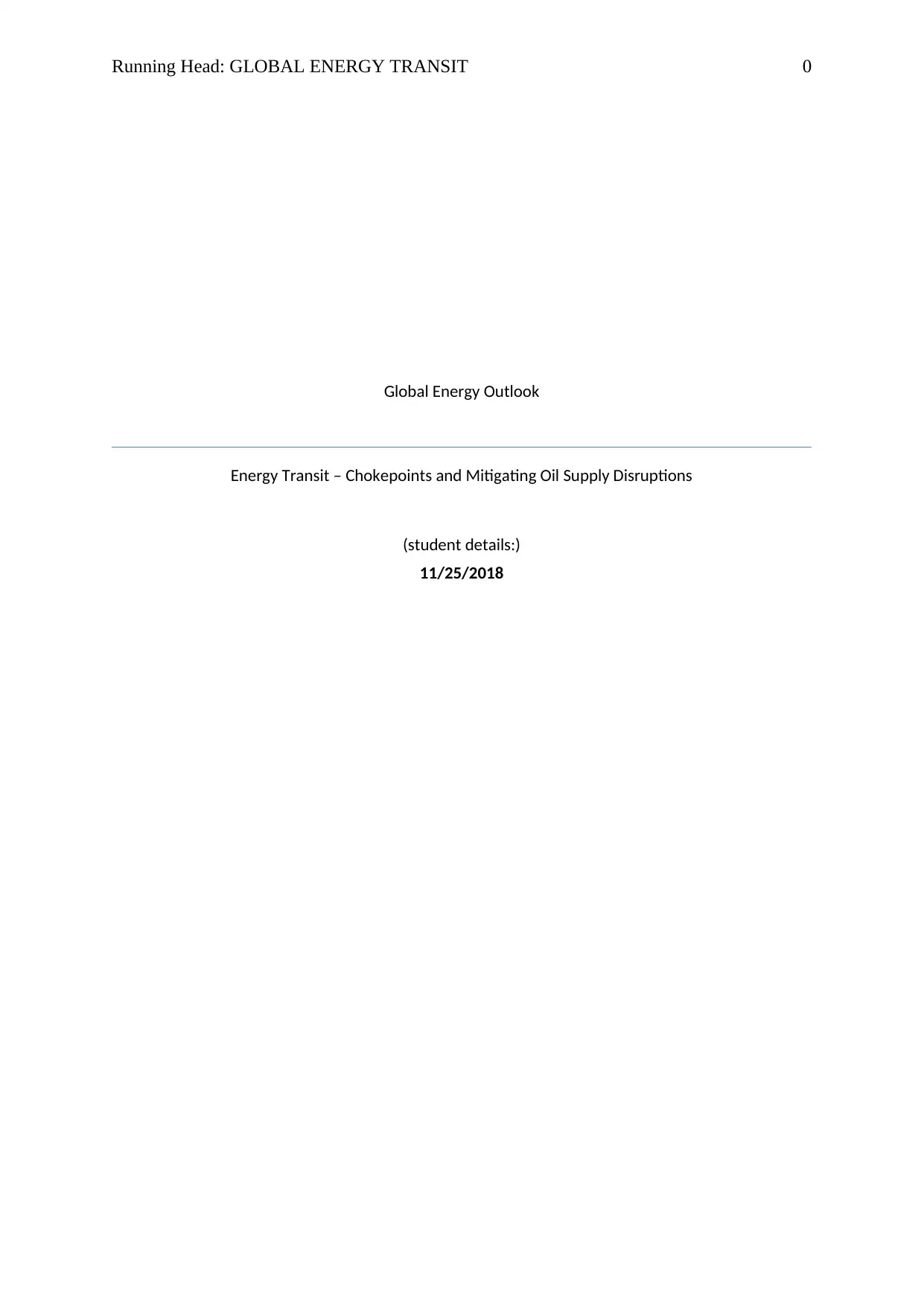
Running Head: GLOBAL ENERGY TRANSIT 0
Global Energy Outlook
Energy Transit – Chokepoints and Mitigating Oil Supply Disruptions
(student details:)
11/25/2018
Global Energy Outlook
Energy Transit – Chokepoints and Mitigating Oil Supply Disruptions
(student details:)
11/25/2018
Paraphrase This Document
Need a fresh take? Get an instant paraphrase of this document with our AI Paraphraser
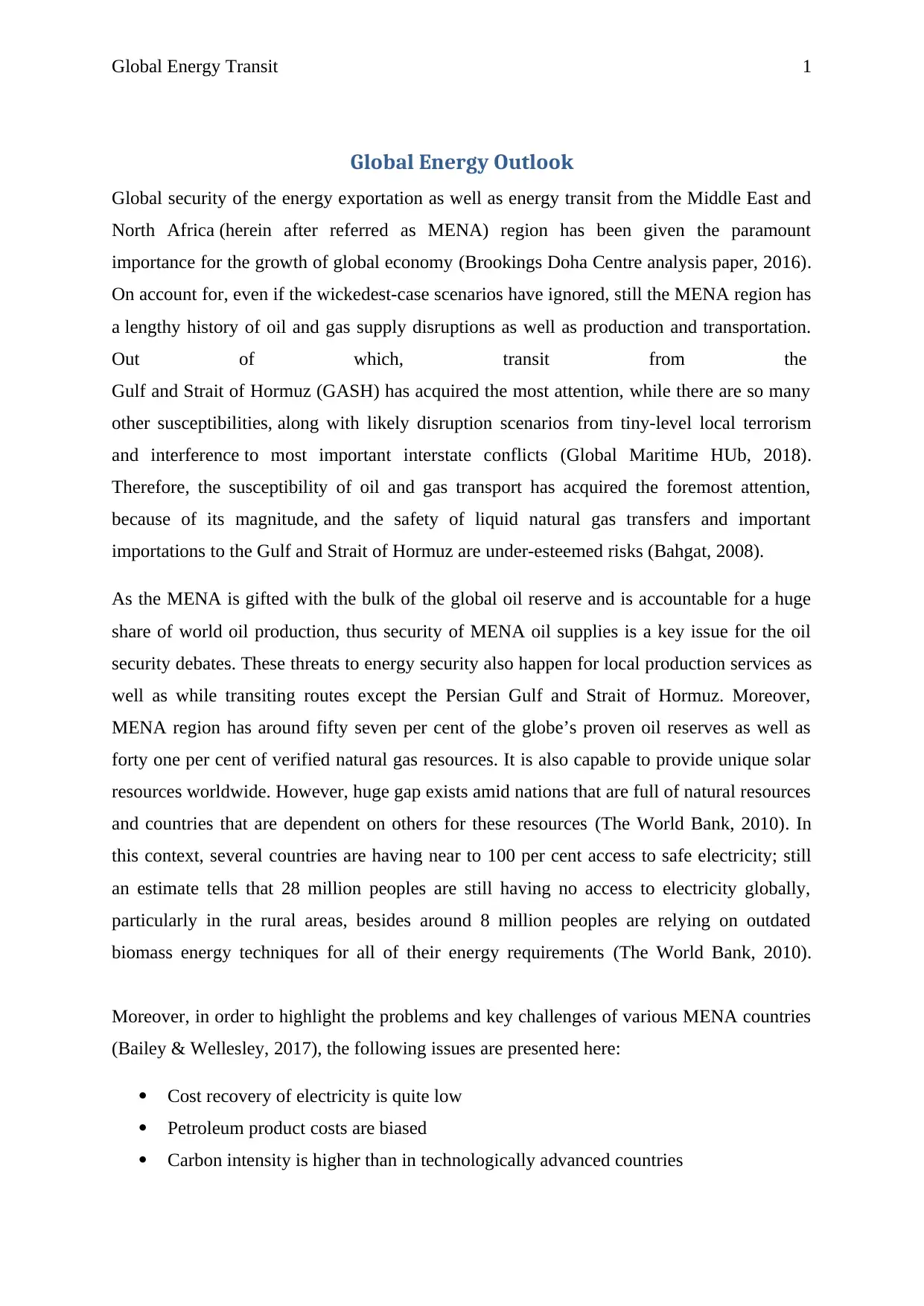
Global Energy Transit 1
Global Energy Outlook
Global security of the energy exportation as well as energy transit from the Middle East and
North Africa (herein after referred as MENA) region has been given the paramount
importance for the growth of global economy (Brookings Doha Centre analysis paper, 2016).
On account for, even if the wickedest-case scenarios have ignored, still the MENA region has
a lengthy history of oil and gas supply disruptions as well as production and transportation.
Out of which, transit from the
Gulf and Strait of Hormuz (GASH) has acquired the most attention, while there are so many
other susceptibilities, along with likely disruption scenarios from tiny-level local terrorism
and interference to most important interstate conflicts (Global Maritime HUb, 2018).
Therefore, the susceptibility of oil and gas transport has acquired the foremost attention,
because of its magnitude, and the safety of liquid natural gas transfers and important
importations to the Gulf and Strait of Hormuz are under-esteemed risks (Bahgat, 2008).
As the MENA is gifted with the bulk of the global oil reserve and is accountable for a huge
share of world oil production, thus security of MENA oil supplies is a key issue for the oil
security debates. These threats to energy security also happen for local production services as
well as while transiting routes except the Persian Gulf and Strait of Hormuz. Moreover,
MENA region has around fifty seven per cent of the globe’s proven oil reserves as well as
forty one per cent of verified natural gas resources. It is also capable to provide unique solar
resources worldwide. However, huge gap exists amid nations that are full of natural resources
and countries that are dependent on others for these resources (The World Bank, 2010). In
this context, several countries are having near to 100 per cent access to safe electricity; still
an estimate tells that 28 million peoples are still having no access to electricity globally,
particularly in the rural areas, besides around 8 million peoples are relying on outdated
biomass energy techniques for all of their energy requirements (The World Bank, 2010).
Moreover, in order to highlight the problems and key challenges of various MENA countries
(Bailey & Wellesley, 2017), the following issues are presented here:
Cost recovery of electricity is quite low
Petroleum product costs are biased
Carbon intensity is higher than in technologically advanced countries
Global Energy Outlook
Global security of the energy exportation as well as energy transit from the Middle East and
North Africa (herein after referred as MENA) region has been given the paramount
importance for the growth of global economy (Brookings Doha Centre analysis paper, 2016).
On account for, even if the wickedest-case scenarios have ignored, still the MENA region has
a lengthy history of oil and gas supply disruptions as well as production and transportation.
Out of which, transit from the
Gulf and Strait of Hormuz (GASH) has acquired the most attention, while there are so many
other susceptibilities, along with likely disruption scenarios from tiny-level local terrorism
and interference to most important interstate conflicts (Global Maritime HUb, 2018).
Therefore, the susceptibility of oil and gas transport has acquired the foremost attention,
because of its magnitude, and the safety of liquid natural gas transfers and important
importations to the Gulf and Strait of Hormuz are under-esteemed risks (Bahgat, 2008).
As the MENA is gifted with the bulk of the global oil reserve and is accountable for a huge
share of world oil production, thus security of MENA oil supplies is a key issue for the oil
security debates. These threats to energy security also happen for local production services as
well as while transiting routes except the Persian Gulf and Strait of Hormuz. Moreover,
MENA region has around fifty seven per cent of the globe’s proven oil reserves as well as
forty one per cent of verified natural gas resources. It is also capable to provide unique solar
resources worldwide. However, huge gap exists amid nations that are full of natural resources
and countries that are dependent on others for these resources (The World Bank, 2010). In
this context, several countries are having near to 100 per cent access to safe electricity; still
an estimate tells that 28 million peoples are still having no access to electricity globally,
particularly in the rural areas, besides around 8 million peoples are relying on outdated
biomass energy techniques for all of their energy requirements (The World Bank, 2010).
Moreover, in order to highlight the problems and key challenges of various MENA countries
(Bailey & Wellesley, 2017), the following issues are presented here:
Cost recovery of electricity is quite low
Petroleum product costs are biased
Carbon intensity is higher than in technologically advanced countries
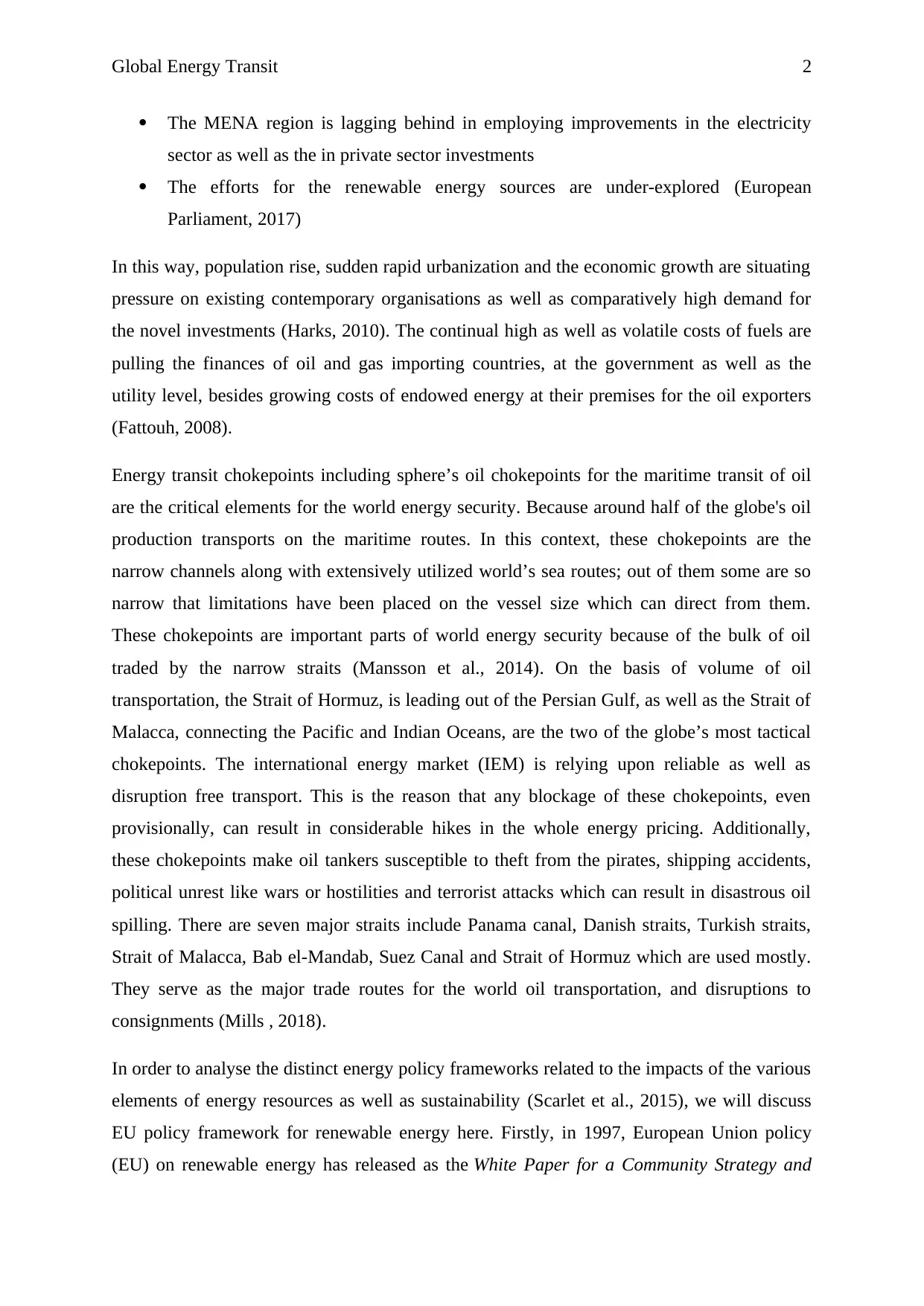
Global Energy Transit 2
The MENA region is lagging behind in employing improvements in the electricity
sector as well as the in private sector investments
The efforts for the renewable energy sources are under-explored (European
Parliament, 2017)
In this way, population rise, sudden rapid urbanization and the economic growth are situating
pressure on existing contemporary organisations as well as comparatively high demand for
the novel investments (Harks, 2010). The continual high as well as volatile costs of fuels are
pulling the finances of oil and gas importing countries, at the government as well as the
utility level, besides growing costs of endowed energy at their premises for the oil exporters
(Fattouh, 2008).
Energy transit chokepoints including sphere’s oil chokepoints for the maritime transit of oil
are the critical elements for the world energy security. Because around half of the globe's oil
production transports on the maritime routes. In this context, these chokepoints are the
narrow channels along with extensively utilized world’s sea routes; out of them some are so
narrow that limitations have been placed on the vessel size which can direct from them.
These chokepoints are important parts of world energy security because of the bulk of oil
traded by the narrow straits (Mansson et al., 2014). On the basis of volume of oil
transportation, the Strait of Hormuz, is leading out of the Persian Gulf, as well as the Strait of
Malacca, connecting the Pacific and Indian Oceans, are the two of the globe’s most tactical
chokepoints. The international energy market (IEM) is relying upon reliable as well as
disruption free transport. This is the reason that any blockage of these chokepoints, even
provisionally, can result in considerable hikes in the whole energy pricing. Additionally,
these chokepoints make oil tankers susceptible to theft from the pirates, shipping accidents,
political unrest like wars or hostilities and terrorist attacks which can result in disastrous oil
spilling. There are seven major straits include Panama canal, Danish straits, Turkish straits,
Strait of Malacca, Bab el-Mandab, Suez Canal and Strait of Hormuz which are used mostly.
They serve as the major trade routes for the world oil transportation, and disruptions to
consignments (Mills , 2018).
In order to analyse the distinct energy policy frameworks related to the impacts of the various
elements of energy resources as well as sustainability (Scarlet et al., 2015), we will discuss
EU policy framework for renewable energy here. Firstly, in 1997, European Union policy
(EU) on renewable energy has released as the White Paper for a Community Strategy and
The MENA region is lagging behind in employing improvements in the electricity
sector as well as the in private sector investments
The efforts for the renewable energy sources are under-explored (European
Parliament, 2017)
In this way, population rise, sudden rapid urbanization and the economic growth are situating
pressure on existing contemporary organisations as well as comparatively high demand for
the novel investments (Harks, 2010). The continual high as well as volatile costs of fuels are
pulling the finances of oil and gas importing countries, at the government as well as the
utility level, besides growing costs of endowed energy at their premises for the oil exporters
(Fattouh, 2008).
Energy transit chokepoints including sphere’s oil chokepoints for the maritime transit of oil
are the critical elements for the world energy security. Because around half of the globe's oil
production transports on the maritime routes. In this context, these chokepoints are the
narrow channels along with extensively utilized world’s sea routes; out of them some are so
narrow that limitations have been placed on the vessel size which can direct from them.
These chokepoints are important parts of world energy security because of the bulk of oil
traded by the narrow straits (Mansson et al., 2014). On the basis of volume of oil
transportation, the Strait of Hormuz, is leading out of the Persian Gulf, as well as the Strait of
Malacca, connecting the Pacific and Indian Oceans, are the two of the globe’s most tactical
chokepoints. The international energy market (IEM) is relying upon reliable as well as
disruption free transport. This is the reason that any blockage of these chokepoints, even
provisionally, can result in considerable hikes in the whole energy pricing. Additionally,
these chokepoints make oil tankers susceptible to theft from the pirates, shipping accidents,
political unrest like wars or hostilities and terrorist attacks which can result in disastrous oil
spilling. There are seven major straits include Panama canal, Danish straits, Turkish straits,
Strait of Malacca, Bab el-Mandab, Suez Canal and Strait of Hormuz which are used mostly.
They serve as the major trade routes for the world oil transportation, and disruptions to
consignments (Mills , 2018).
In order to analyse the distinct energy policy frameworks related to the impacts of the various
elements of energy resources as well as sustainability (Scarlet et al., 2015), we will discuss
EU policy framework for renewable energy here. Firstly, in 1997, European Union policy
(EU) on renewable energy has released as the White Paper for a Community Strategy and
⊘ This is a preview!⊘
Do you want full access?
Subscribe today to unlock all pages.

Trusted by 1+ million students worldwide
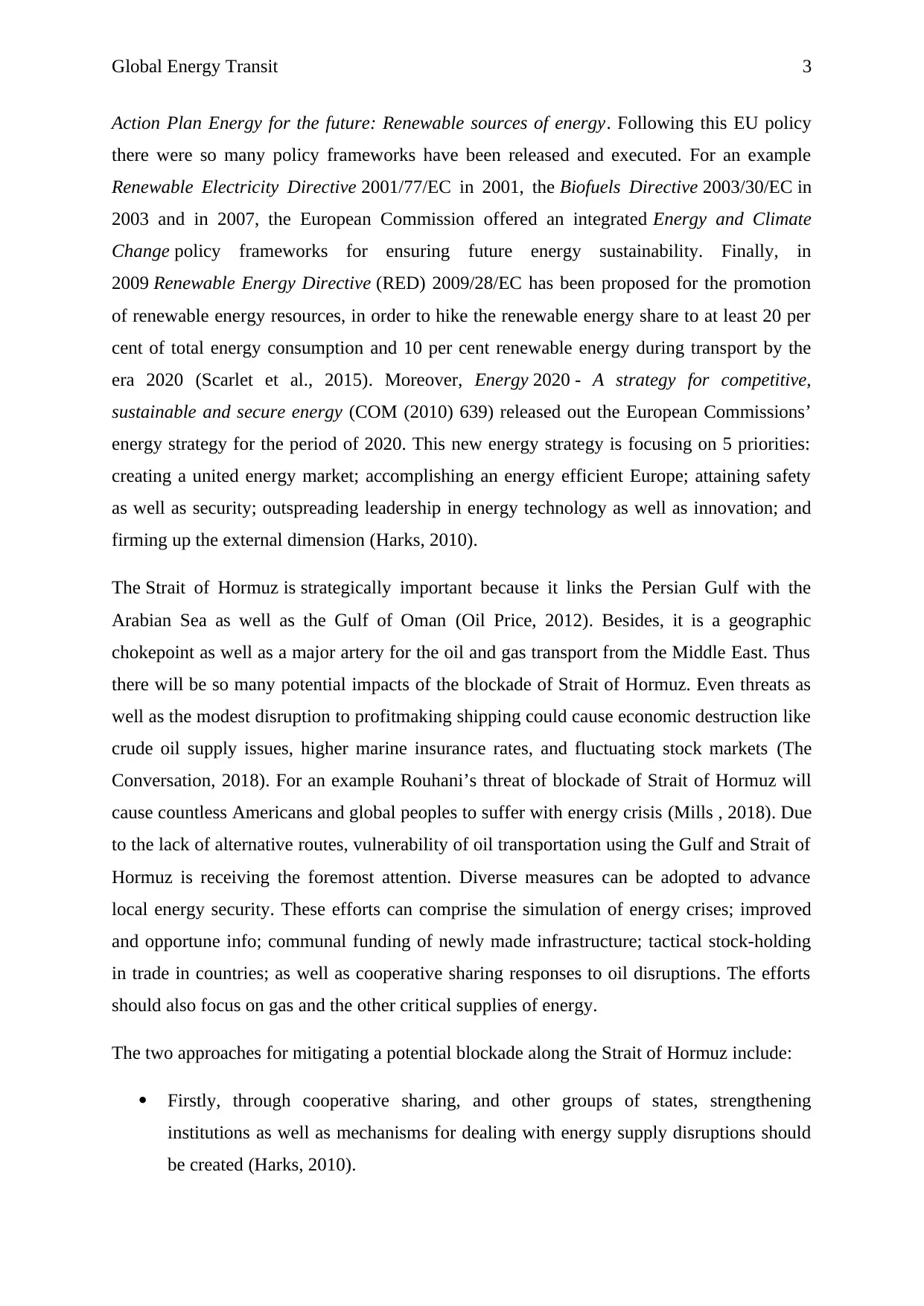
Global Energy Transit 3
Action Plan Energy for the future: Renewable sources of energy. Following this EU policy
there were so many policy frameworks have been released and executed. For an example
Renewable Electricity Directive 2001/77/EC in 2001, the Biofuels Directive 2003/30/EC in
2003 and in 2007, the European Commission offered an integrated Energy and Climate
Change policy frameworks for ensuring future energy sustainability. Finally, in
2009 Renewable Energy Directive (RED) 2009/28/EC has been proposed for the promotion
of renewable energy resources, in order to hike the renewable energy share to at least 20 per
cent of total energy consumption and 10 per cent renewable energy during transport by the
era 2020 (Scarlet et al., 2015). Moreover, Energy 2020 - A strategy for competitive,
sustainable and secure energy (COM (2010) 639) released out the European Commissions’
energy strategy for the period of 2020. This new energy strategy is focusing on 5 priorities:
creating a united energy market; accomplishing an energy efficient Europe; attaining safety
as well as security; outspreading leadership in energy technology as well as innovation; and
firming up the external dimension (Harks, 2010).
The Strait of Hormuz is strategically important because it links the Persian Gulf with the
Arabian Sea as well as the Gulf of Oman (Oil Price, 2012). Besides, it is a geographic
chokepoint as well as a major artery for the oil and gas transport from the Middle East. Thus
there will be so many potential impacts of the blockade of Strait of Hormuz. Even threats as
well as the modest disruption to profitmaking shipping could cause economic destruction like
crude oil supply issues, higher marine insurance rates, and fluctuating stock markets (The
Conversation, 2018). For an example Rouhani’s threat of blockade of Strait of Hormuz will
cause countless Americans and global peoples to suffer with energy crisis (Mills , 2018). Due
to the lack of alternative routes, vulnerability of oil transportation using the Gulf and Strait of
Hormuz is receiving the foremost attention. Diverse measures can be adopted to advance
local energy security. These efforts can comprise the simulation of energy crises; improved
and opportune info; communal funding of newly made infrastructure; tactical stock-holding
in trade in countries; as well as cooperative sharing responses to oil disruptions. The efforts
should also focus on gas and the other critical supplies of energy.
The two approaches for mitigating a potential blockade along the Strait of Hormuz include:
Firstly, through cooperative sharing, and other groups of states, strengthening
institutions as well as mechanisms for dealing with energy supply disruptions should
be created (Harks, 2010).
Action Plan Energy for the future: Renewable sources of energy. Following this EU policy
there were so many policy frameworks have been released and executed. For an example
Renewable Electricity Directive 2001/77/EC in 2001, the Biofuels Directive 2003/30/EC in
2003 and in 2007, the European Commission offered an integrated Energy and Climate
Change policy frameworks for ensuring future energy sustainability. Finally, in
2009 Renewable Energy Directive (RED) 2009/28/EC has been proposed for the promotion
of renewable energy resources, in order to hike the renewable energy share to at least 20 per
cent of total energy consumption and 10 per cent renewable energy during transport by the
era 2020 (Scarlet et al., 2015). Moreover, Energy 2020 - A strategy for competitive,
sustainable and secure energy (COM (2010) 639) released out the European Commissions’
energy strategy for the period of 2020. This new energy strategy is focusing on 5 priorities:
creating a united energy market; accomplishing an energy efficient Europe; attaining safety
as well as security; outspreading leadership in energy technology as well as innovation; and
firming up the external dimension (Harks, 2010).
The Strait of Hormuz is strategically important because it links the Persian Gulf with the
Arabian Sea as well as the Gulf of Oman (Oil Price, 2012). Besides, it is a geographic
chokepoint as well as a major artery for the oil and gas transport from the Middle East. Thus
there will be so many potential impacts of the blockade of Strait of Hormuz. Even threats as
well as the modest disruption to profitmaking shipping could cause economic destruction like
crude oil supply issues, higher marine insurance rates, and fluctuating stock markets (The
Conversation, 2018). For an example Rouhani’s threat of blockade of Strait of Hormuz will
cause countless Americans and global peoples to suffer with energy crisis (Mills , 2018). Due
to the lack of alternative routes, vulnerability of oil transportation using the Gulf and Strait of
Hormuz is receiving the foremost attention. Diverse measures can be adopted to advance
local energy security. These efforts can comprise the simulation of energy crises; improved
and opportune info; communal funding of newly made infrastructure; tactical stock-holding
in trade in countries; as well as cooperative sharing responses to oil disruptions. The efforts
should also focus on gas and the other critical supplies of energy.
The two approaches for mitigating a potential blockade along the Strait of Hormuz include:
Firstly, through cooperative sharing, and other groups of states, strengthening
institutions as well as mechanisms for dealing with energy supply disruptions should
be created (Harks, 2010).
Paraphrase This Document
Need a fresh take? Get an instant paraphrase of this document with our AI Paraphraser
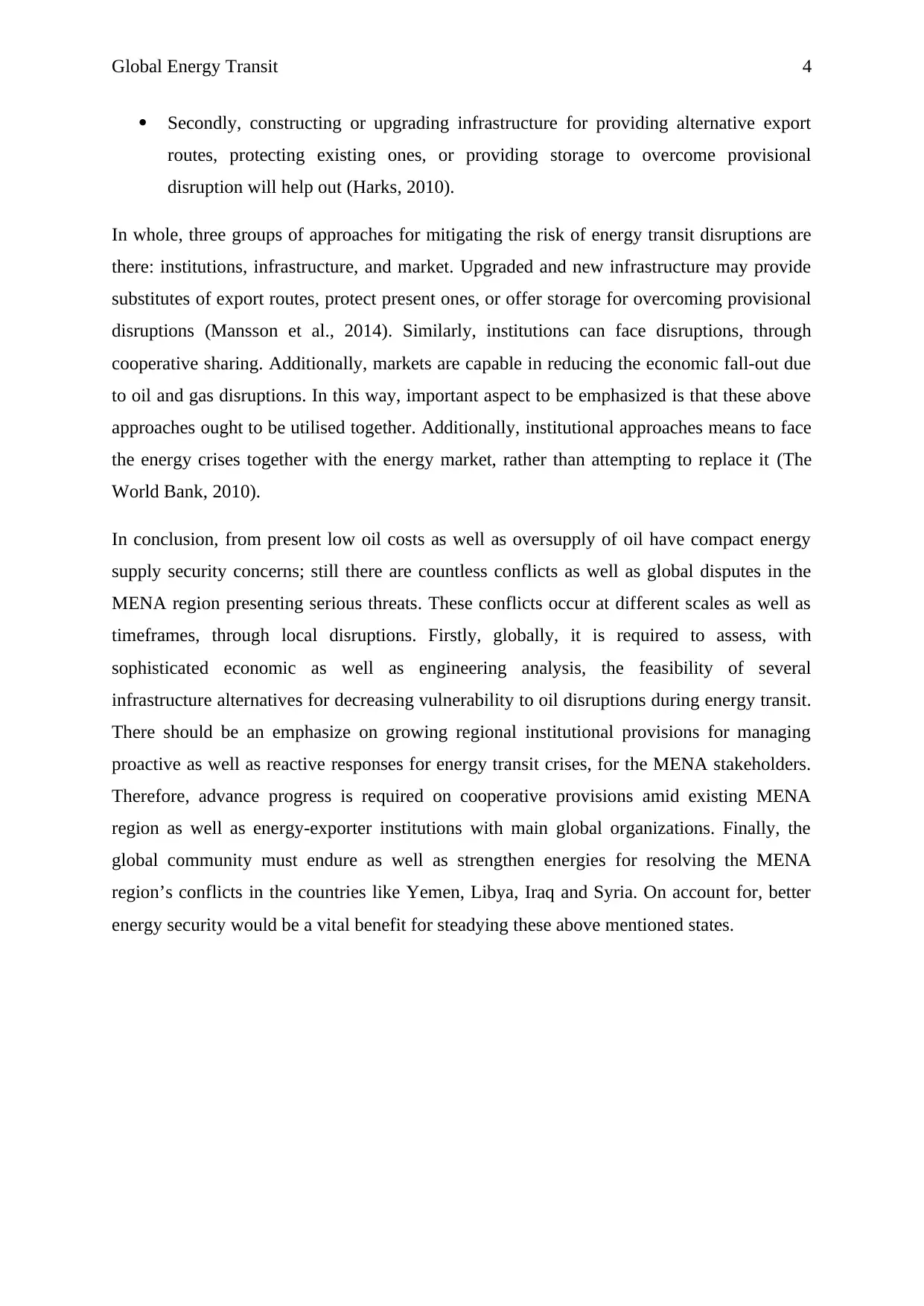
Global Energy Transit 4
Secondly, constructing or upgrading infrastructure for providing alternative export
routes, protecting existing ones, or providing storage to overcome provisional
disruption will help out (Harks, 2010).
In whole, three groups of approaches for mitigating the risk of energy transit disruptions are
there: institutions, infrastructure, and market. Upgraded and new infrastructure may provide
substitutes of export routes, protect present ones, or offer storage for overcoming provisional
disruptions (Mansson et al., 2014). Similarly, institutions can face disruptions, through
cooperative sharing. Additionally, markets are capable in reducing the economic fall-out due
to oil and gas disruptions. In this way, important aspect to be emphasized is that these above
approaches ought to be utilised together. Additionally, institutional approaches means to face
the energy crises together with the energy market, rather than attempting to replace it (The
World Bank, 2010).
In conclusion, from present low oil costs as well as oversupply of oil have compact energy
supply security concerns; still there are countless conflicts as well as global disputes in the
MENA region presenting serious threats. These conflicts occur at different scales as well as
timeframes, through local disruptions. Firstly, globally, it is required to assess, with
sophisticated economic as well as engineering analysis, the feasibility of several
infrastructure alternatives for decreasing vulnerability to oil disruptions during energy transit.
There should be an emphasize on growing regional institutional provisions for managing
proactive as well as reactive responses for energy transit crises, for the MENA stakeholders.
Therefore, advance progress is required on cooperative provisions amid existing MENA
region as well as energy-exporter institutions with main global organizations. Finally, the
global community must endure as well as strengthen energies for resolving the MENA
region’s conflicts in the countries like Yemen, Libya, Iraq and Syria. On account for, better
energy security would be a vital benefit for steadying these above mentioned states.
Secondly, constructing or upgrading infrastructure for providing alternative export
routes, protecting existing ones, or providing storage to overcome provisional
disruption will help out (Harks, 2010).
In whole, three groups of approaches for mitigating the risk of energy transit disruptions are
there: institutions, infrastructure, and market. Upgraded and new infrastructure may provide
substitutes of export routes, protect present ones, or offer storage for overcoming provisional
disruptions (Mansson et al., 2014). Similarly, institutions can face disruptions, through
cooperative sharing. Additionally, markets are capable in reducing the economic fall-out due
to oil and gas disruptions. In this way, important aspect to be emphasized is that these above
approaches ought to be utilised together. Additionally, institutional approaches means to face
the energy crises together with the energy market, rather than attempting to replace it (The
World Bank, 2010).
In conclusion, from present low oil costs as well as oversupply of oil have compact energy
supply security concerns; still there are countless conflicts as well as global disputes in the
MENA region presenting serious threats. These conflicts occur at different scales as well as
timeframes, through local disruptions. Firstly, globally, it is required to assess, with
sophisticated economic as well as engineering analysis, the feasibility of several
infrastructure alternatives for decreasing vulnerability to oil disruptions during energy transit.
There should be an emphasize on growing regional institutional provisions for managing
proactive as well as reactive responses for energy transit crises, for the MENA stakeholders.
Therefore, advance progress is required on cooperative provisions amid existing MENA
region as well as energy-exporter institutions with main global organizations. Finally, the
global community must endure as well as strengthen energies for resolving the MENA
region’s conflicts in the countries like Yemen, Libya, Iraq and Syria. On account for, better
energy security would be a vital benefit for steadying these above mentioned states.
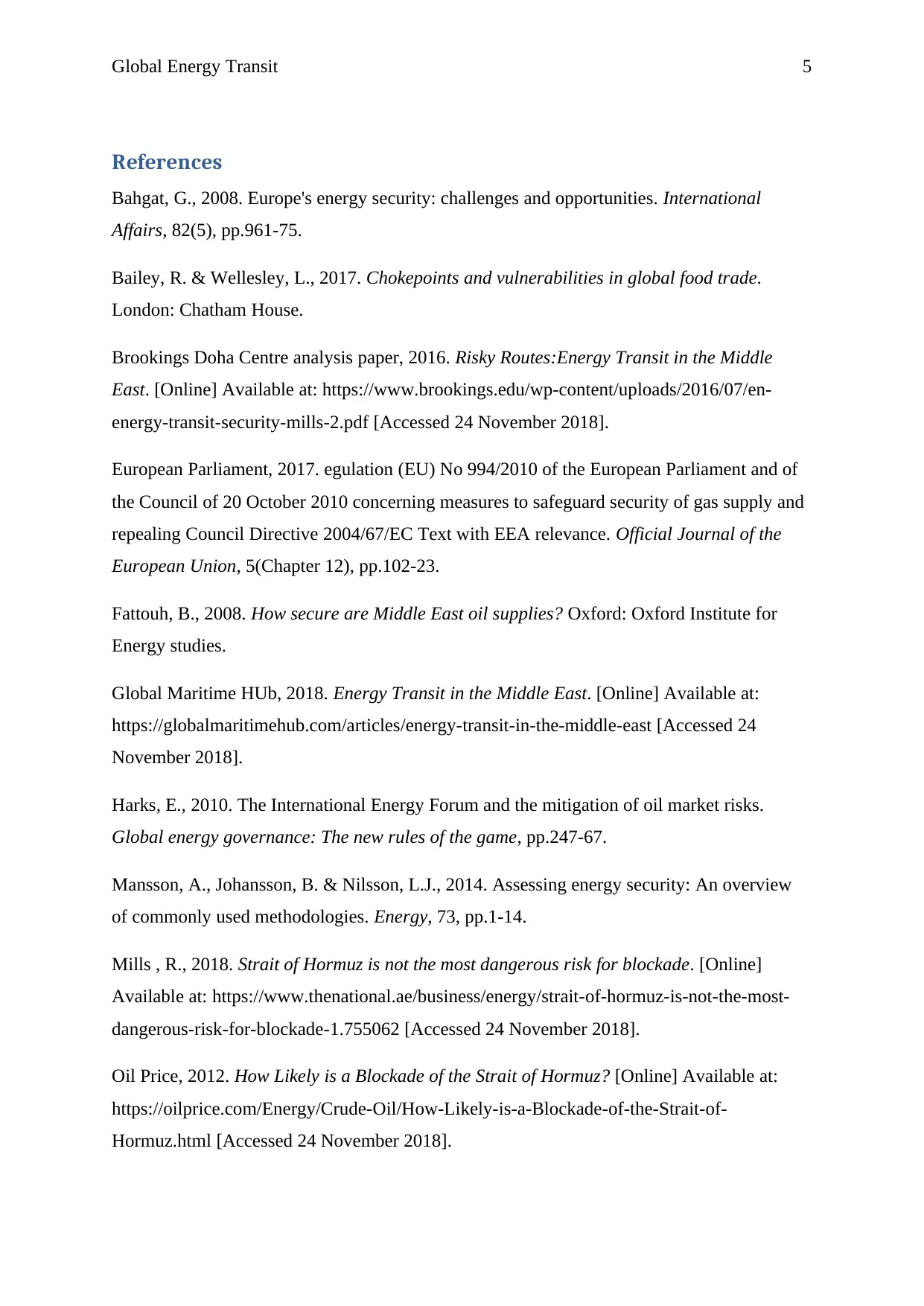
Global Energy Transit 5
References
Bahgat, G., 2008. Europe's energy security: challenges and opportunities. International
Affairs, 82(5), pp.961-75.
Bailey, R. & Wellesley, L., 2017. Chokepoints and vulnerabilities in global food trade.
London: Chatham House.
Brookings Doha Centre analysis paper, 2016. Risky Routes:Energy Transit in the Middle
East. [Online] Available at: https://www.brookings.edu/wp-content/uploads/2016/07/en-
energy-transit-security-mills-2.pdf [Accessed 24 November 2018].
European Parliament, 2017. egulation (EU) No 994/2010 of the European Parliament and of
the Council of 20 October 2010 concerning measures to safeguard security of gas supply and
repealing Council Directive 2004/67/EC Text with EEA relevance. Official Journal of the
European Union, 5(Chapter 12), pp.102-23.
Fattouh, B., 2008. How secure are Middle East oil supplies? Oxford: Oxford Institute for
Energy studies.
Global Maritime HUb, 2018. Energy Transit in the Middle East. [Online] Available at:
https://globalmaritimehub.com/articles/energy-transit-in-the-middle-east [Accessed 24
November 2018].
Harks, E., 2010. The International Energy Forum and the mitigation of oil market risks.
Global energy governance: The new rules of the game, pp.247-67.
Mansson, A., Johansson, B. & Nilsson, L.J., 2014. Assessing energy security: An overview
of commonly used methodologies. Energy, 73, pp.1-14.
Mills , R., 2018. Strait of Hormuz is not the most dangerous risk for blockade. [Online]
Available at: https://www.thenational.ae/business/energy/strait-of-hormuz-is-not-the-most-
dangerous-risk-for-blockade-1.755062 [Accessed 24 November 2018].
Oil Price, 2012. How Likely is a Blockade of the Strait of Hormuz? [Online] Available at:
https://oilprice.com/Energy/Crude-Oil/How-Likely-is-a-Blockade-of-the-Strait-of-
Hormuz.html [Accessed 24 November 2018].
References
Bahgat, G., 2008. Europe's energy security: challenges and opportunities. International
Affairs, 82(5), pp.961-75.
Bailey, R. & Wellesley, L., 2017. Chokepoints and vulnerabilities in global food trade.
London: Chatham House.
Brookings Doha Centre analysis paper, 2016. Risky Routes:Energy Transit in the Middle
East. [Online] Available at: https://www.brookings.edu/wp-content/uploads/2016/07/en-
energy-transit-security-mills-2.pdf [Accessed 24 November 2018].
European Parliament, 2017. egulation (EU) No 994/2010 of the European Parliament and of
the Council of 20 October 2010 concerning measures to safeguard security of gas supply and
repealing Council Directive 2004/67/EC Text with EEA relevance. Official Journal of the
European Union, 5(Chapter 12), pp.102-23.
Fattouh, B., 2008. How secure are Middle East oil supplies? Oxford: Oxford Institute for
Energy studies.
Global Maritime HUb, 2018. Energy Transit in the Middle East. [Online] Available at:
https://globalmaritimehub.com/articles/energy-transit-in-the-middle-east [Accessed 24
November 2018].
Harks, E., 2010. The International Energy Forum and the mitigation of oil market risks.
Global energy governance: The new rules of the game, pp.247-67.
Mansson, A., Johansson, B. & Nilsson, L.J., 2014. Assessing energy security: An overview
of commonly used methodologies. Energy, 73, pp.1-14.
Mills , R., 2018. Strait of Hormuz is not the most dangerous risk for blockade. [Online]
Available at: https://www.thenational.ae/business/energy/strait-of-hormuz-is-not-the-most-
dangerous-risk-for-blockade-1.755062 [Accessed 24 November 2018].
Oil Price, 2012. How Likely is a Blockade of the Strait of Hormuz? [Online] Available at:
https://oilprice.com/Energy/Crude-Oil/How-Likely-is-a-Blockade-of-the-Strait-of-
Hormuz.html [Accessed 24 November 2018].
⊘ This is a preview!⊘
Do you want full access?
Subscribe today to unlock all pages.

Trusted by 1+ million students worldwide
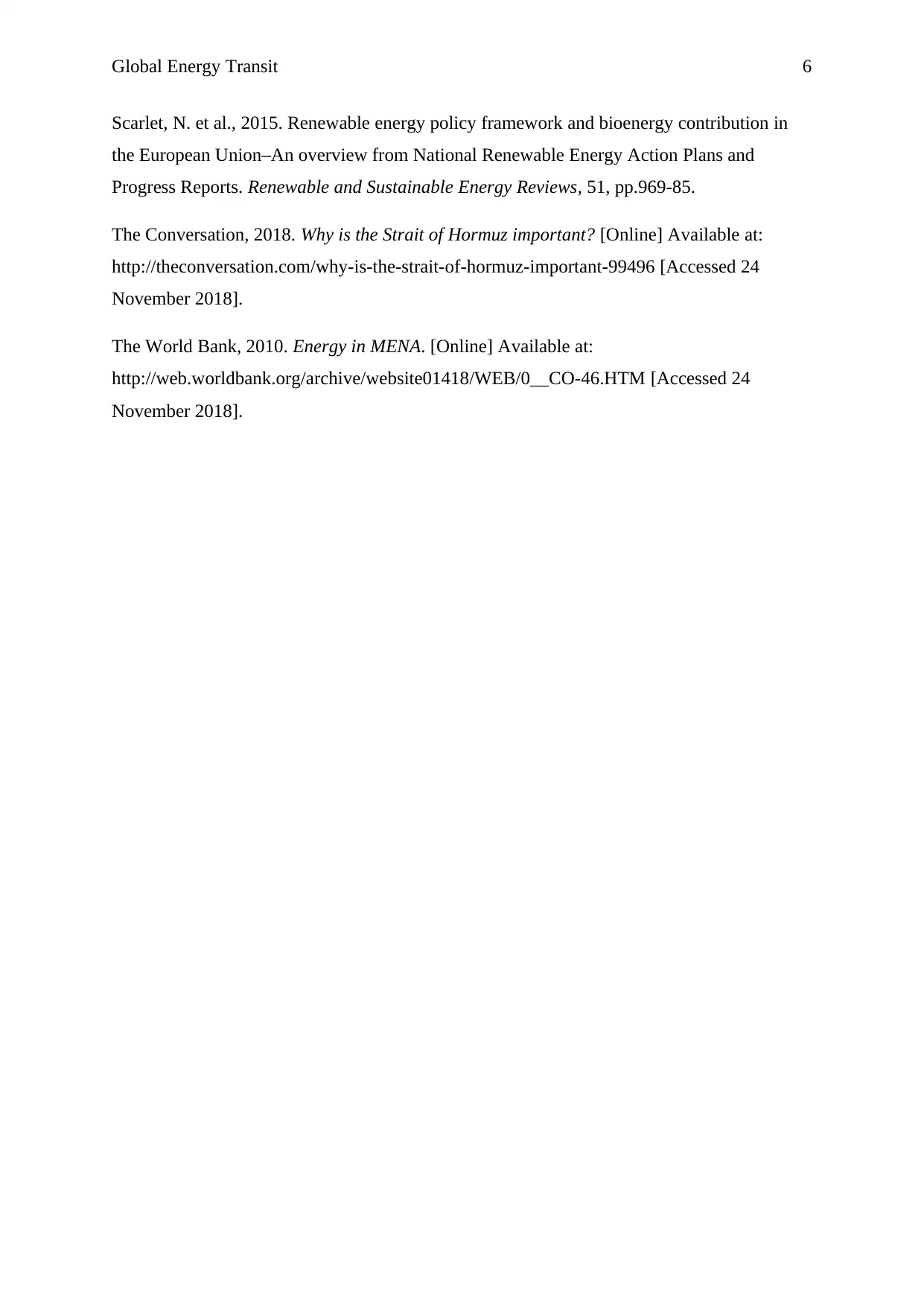
Global Energy Transit 6
Scarlet, N. et al., 2015. Renewable energy policy framework and bioenergy contribution in
the European Union–An overview from National Renewable Energy Action Plans and
Progress Reports. Renewable and Sustainable Energy Reviews, 51, pp.969-85.
The Conversation, 2018. Why is the Strait of Hormuz important? [Online] Available at:
http://theconversation.com/why-is-the-strait-of-hormuz-important-99496 [Accessed 24
November 2018].
The World Bank, 2010. Energy in MENA. [Online] Available at:
http://web.worldbank.org/archive/website01418/WEB/0__CO-46.HTM [Accessed 24
November 2018].
Scarlet, N. et al., 2015. Renewable energy policy framework and bioenergy contribution in
the European Union–An overview from National Renewable Energy Action Plans and
Progress Reports. Renewable and Sustainable Energy Reviews, 51, pp.969-85.
The Conversation, 2018. Why is the Strait of Hormuz important? [Online] Available at:
http://theconversation.com/why-is-the-strait-of-hormuz-important-99496 [Accessed 24
November 2018].
The World Bank, 2010. Energy in MENA. [Online] Available at:
http://web.worldbank.org/archive/website01418/WEB/0__CO-46.HTM [Accessed 24
November 2018].
1 out of 7
Related Documents
Your All-in-One AI-Powered Toolkit for Academic Success.
+13062052269
info@desklib.com
Available 24*7 on WhatsApp / Email
![[object Object]](/_next/static/media/star-bottom.7253800d.svg)
Unlock your academic potential
Copyright © 2020–2025 A2Z Services. All Rights Reserved. Developed and managed by ZUCOL.


![Energy Security: Regional Dimensions Essay - [University Name]](/_next/image/?url=https%3A%2F%2Fdesklib.com%2Fmedia%2Fimages%2Fda%2F83117328299f4e9da5664a7fcb7634cb.jpg&w=256&q=75)

